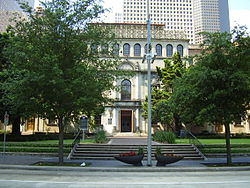
Ralph Adams Cram was a prolific and influential American architect of collegiate and ecclesiastical buildings, often in the Gothic Revival style. Cram & Ferguson and Cram, Goodhue & Ferguson are partnerships in which he worked. Cram was a fellow of the American Institute of Architects.

The Houston Chronicle is the largest daily newspaper in Houston, Texas, United States. As of April 2016, it is the third-largest newspaper by Sunday circulation in the United States, behind only The New York Times and the Los Angeles Times. With its 1995 buy-out of long-time rival the Houston Post, the Chronicle became Houston's newspaper of record.

Downtown is the largest central business district in the city of Houston and the largest in the state of Texas, located near the geographic center of the metropolitan area at the confluence of Interstate 10, Interstate 45, and Interstate 69. The 1.84-square-mile (4.8 km2) district, enclosed by the aforementioned highways, contains the original townsite of Houston at the confluence of Buffalo Bayou and White Oak Bayou, a point known as Allen's Landing. Downtown has been the city's preeminent commercial district since its founding in 1836.

Houston Public Library is the public library system serving Houston, Texas, United States.

The Houston Post was a newspaper that had its headquarters in Houston, Texas, United States. In 1995, the newspaper shut down, and its assets were purchased by the Houston Chronicle.

Trinity Church, in Midtown Houston, Texas, is a parish church in the Episcopal Diocese of Texas.

Rice Military is a neighborhood in Houston, Texas, United States. The Beer Can House is located in Rice Military.

Edgar Allan Poe Elementary School is a primary school located at 5100 Hazard Street in Houston, Texas, United States. A part of the Houston Independent School District (HISD), the school, which was built during the 1920s, is located in the Chevy Chase subdivision of the Boulevard Oaks neighborhood west of Rice University. The school, a National Register of Historic Places (NRHP) historic district contributing property of Boulevard Oaks, was named after Edgar Allan Poe.

Fourth Ward is one of the historic six wards of Houston, Texas, United States. The Fourth Ward is located inside the 610 Loop directly west of and adjacent to Downtown Houston. The Fourth Ward is the site of Freedmen's Town, which was a post-U.S. Civil War community of African-Americans.
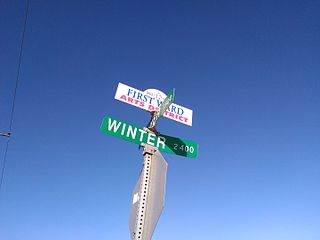
The First Ward of Houston, which is located inside the 610 Loop, is one of the city's historic wards. It was originally the center of the business district for the city, and was strategically located at the intersection of Buffalo Bayou and White Oak Bayou, near an area now known as Allen's Landing. It was one of the original four wards in Houston when it was created in 1840. It was defined as all area within the city limits of Houston north of Congress Street and west of Main Street.
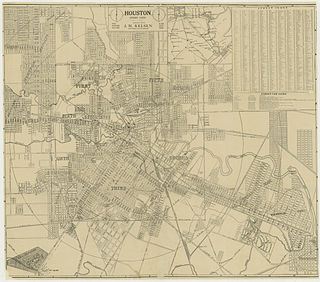
When the city of Houston was founded in 1836 and incorporated in 1837, its founders—John Kirby Allen and Augustus Chapman Allen—divided it into political geographic districts called "wards". The ward system, a precursor to today's City Council districts, was a common political tool of the early 19th century, and is still used in some American cities. When the system was at its peak, the city had six wards, from the first to the sixth.

The flag of Houston is the official flag of the city of Houston. It consists of a large white five-pointed star on a blue background with the city's seal set within the star. The flag was adopted in 1915.
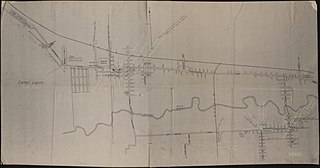
Camp Logan was a World War I-era army training camp in Houston, Texas named after U.S. Senator and Civil War General John A. Logan. The site of the camp is now primarily occupied by Memorial Park where it borders the Crestwood neighborhood, near Memorial Elementary School. Some chunks of concrete, many building foundations, and extensive trenches used for training or middens still remain in the heavily forested park. Many of the trails through the park in this area trace the routes of old Camp Logan roads. One stretch of a Camp Logan road remains in original condition, that being the shell-surfaced service road to the golf course.

The Rice, formerly the Rice Hotel, is an historic building at 909 Texas Avenue in Downtown Houston, Texas, United States. The current building is the third to occupy the site. It was completed in 1913 on the site of the former Capitol building of the Republic of Texas, and is listed on the National Register of Historic Places. The old Capitol building was operated as a hotel until it was torn down and replaced by a new hotel around 1881. Jesse H. Jones built a new seventeen-story, double-winged hotel in 1913, also called "The Rice Hotel." This building underwent major expansions: adding a third wing in 1925, adding an eighteenth floor in 1951, and adding a five-story "motor lobby" in 1958. In addition, there were several renovations during its life as a hotel. It continued to operate as a hotel before finally shutting down in 1977. After standing vacant for twenty-one years, The Rice was renovated as apartments and reopened in 1998 as the Post Rice Lofts. It was sold in 2014 and renamed simply The Rice.
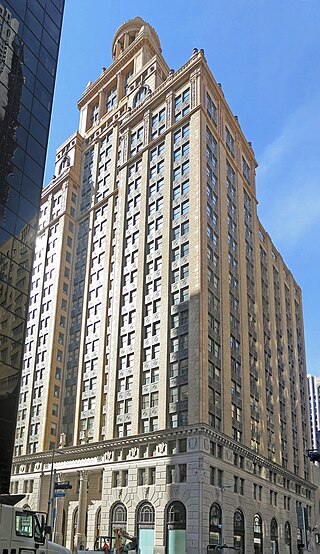
The Niels and Mellie Esperson Buildings are a building complex in downtown Houston, Texas. Mary Ann Azevedo of the Houston Business Journal said that they were "among the most recognizable" buildings in Downtown.
William Ward Watkin was an architect primarily practicing in Houston, Texas. He was the founder of the Architecture Department of Rice University in 1912, and remained on the Rice faculty until his death. Concurrently, he also designed a number of important projects, mostly in the Houston area.

The Cotton Exchange Building is a historic building located in downtown Houston. Built in 1884, it is listed on the National Register of Historic Places. The Houston Cotton Exchange and Board of Trade commissioned local architect Eugene Heiner to design a three-story building on Travis Street at the corner of Franklin in Houston. In 1907, the building was remodeled and a fourth floor added. The Houston Cotton Exchange continued to use the building until it moved its operations to a new building several blocks away at Prairie and Caroline in 1924.

The JW Marriott Downtown Houston is a hotel located at 806 Main Street in Downtown Houston, which opened in 2014. It had been previously known as the Carter Building, and was the tallest building in Texas when it opened in 1910. The building was renamed Second National Bank Building in 1923.

The Texas Company Building, located at 1111 Rusk in Houston, Texas, was listed on the National Register of Historic Places on April 2, 2003.

Julia Bedford Ideson (1880–1945) was the first head librarian of the Houston Public Library in Houston, Texas. She served in her role for forty-years, serving as a leader in the library science profession and many community activities in Houston. She was a proponent of professional opportunities for women and was the leader of a primarily-female library staff. The Julia Ideson Building, currently owned by the Houston Public Library, was named in her honor.
